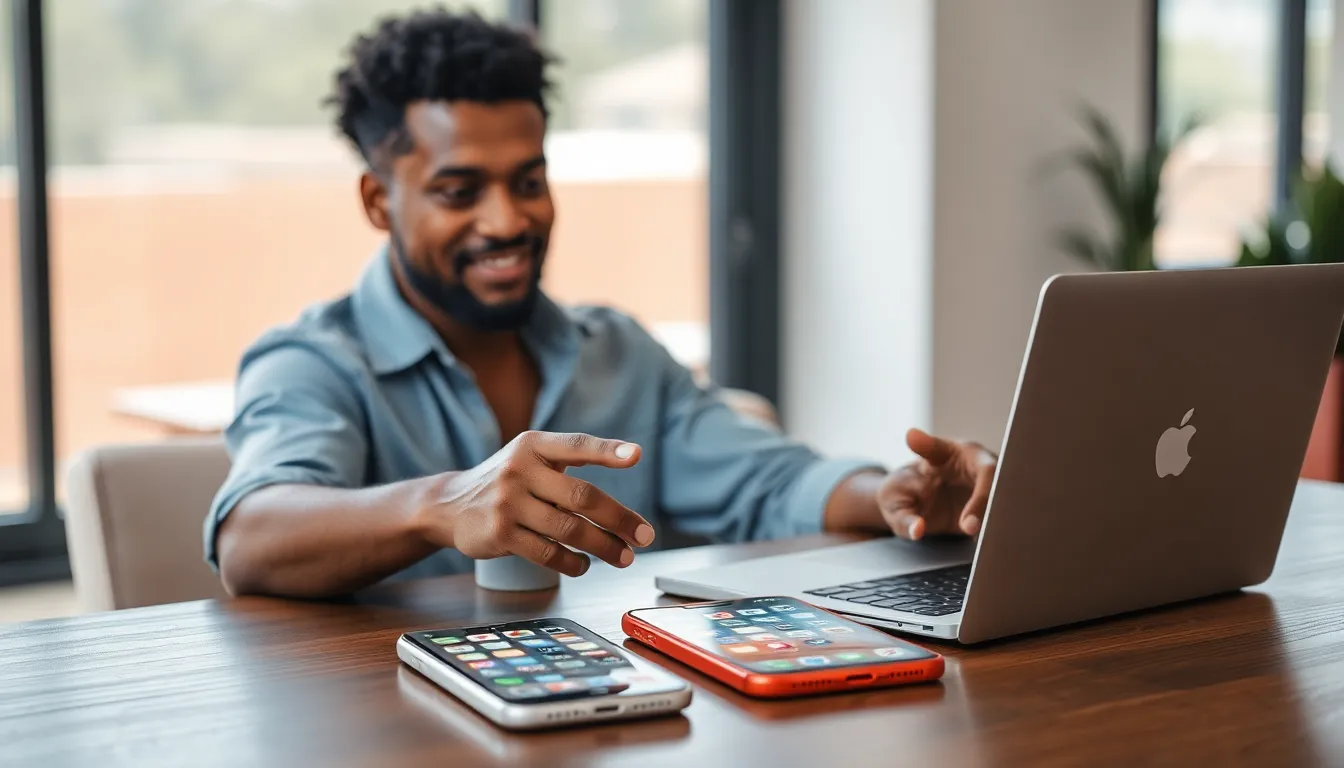Upgrading to a new iPhone is like getting a shiny new toy, but transferring all those beloved apps can feel like a game of digital Tetris. Don’t worry; it’s easier than finding a matching sock in a laundry basket! With a little guidance, anyone can seamlessly move their apps and keep their digital life intact.
Table of Contents
ToggleOverview of Moving Apps to New iPhone
Moving apps to a new iPhone requires a few straightforward steps. First, users should ensure both devices are connected to Wi-Fi. A reliable connection speeds up the transfer process. Next, Apple’s built-in migration tool allows app transfers during the setup phase. Opting for this method simplifies transferring apps along with settings and data.
Some users prefer to download apps directly from the App Store on their new iPhone. Opening the App Store reveals a “Purchased” section, where they can see all previously downloaded apps. Selecting and installing them individually ensures that each app is up-to-date.
Additionally, iCloud plays a significant role in transferring apps. Users with iCloud backups can restore their new iPhone using their most recent backup. This approach reinstates apps along with associated data seamlessly.
Transferring apps via iTunes remains another effective method. Connecting the old iPhone to a computer and syncing it with iTunes allows for back-up and installation of apps on the new device. Ensuring that iTunes is updated to the latest version ensures compatibility.
Lastly, users should always verify if apps require any specific settings after the transfer. Some apps might require logging back in or adjusting preferences. Following these steps ensures a smooth transition, allowing users to enjoy their new iPhone right away.
Preparing Your Old and New iPhones

Transferring apps from an old iPhone to a new one involves a few preparation steps. Ensure both devices are primed for the process to allow for a smooth transition.
Backup Your Old iPhone
Start by backing up the old iPhone. Users can opt for iCloud or iTunes for this task. iCloud backups happen wirelessly, storing data in the cloud for easy access. To do this, go to Settings, tap on your name, select iCloud, and choose Backup. Tap “Back Up Now” to initiate the process. For iTunes, connect the iPhone to a computer and select “Back Up Now” after locating the device in iTunes. Confirm that the backup is complete before proceeding to the next step.
Ensure Your New iPhone is Ready
Preparing the new iPhone requires verifying its setup. Users should turn on the device and follow the on-screen instructions until reaching the “Apps & Data” screen. Connecting to Wi-Fi ensures a stable setup process. It’s essential to choose the migration method during this stage. Selecting “Restore from iCloud Backup” or “Transfer Directly from iPhone” allows for the transfer of apps and data. A fully charged battery is necessary to complete the transfer without interruption.
Methods to Move Apps to New iPhone
Several methods exist for transferring apps to a new iPhone, each offering unique benefits. Using iCloud, iTunes/Finder, and Quick Start allows users to quickly and efficiently move their digital content.
Using iCloud
iCloud provides a straightforward way to move apps effortlessly. Users back up their old iPhone by navigating to Settings, tapping on their name, and selecting iCloud Backup. Once the backup completes, they set up their new iPhone, choose “Restore from iCloud Backup,” and sign in with their Apple ID. This process pulls apps and associated data from the most recent backup. Users can enjoy a seamless transition as iCloud manages the installation and organization of apps automatically.
Using iTunes/Finder
Using iTunes or Finder makes transferring apps direct and efficient. First, users connect their old iPhone to a computer with either iTunes or Finder open. The next step involves selecting the device and choosing “Back Up Now” to create a full backup. After backing up, they connect the new iPhone, select “Restore Backup,” and plant the correct backup file. This option restores apps, settings, and other data together, ensuring a convenient setup.
Using Quick Start
Quick Start offers an instant transfer method using both devices. Users simply place their new iPhone near the old one to activate Quick Start during setup. They use their old iPhone to authenticate and initiate the process. Apps, settings, and preferences migrate smoothly without needing computer assistance. This method works best when both devices have up-to-date software, maximizing efficiency and ease.
Verifying App Migration
Verifying app migration ensures a smooth transition to the new iPhone. Users must confirm that all essential applications function properly after the transfer.
Checking App Functionality
Checking app functionality involves launching each app to ensure they work as intended. Users should pay close attention to apps requiring login credentials, ensuring smooth access. Additionally, checking for any missing content or settings is crucial for a complete user experience. If an app does not function properly, reinstalling or updating it may resolve issues. Users can also utilize the App Store to check for updates, which can enhance the app’s performance on the new device.
Re-Downloading Missing Apps
Re-downloading missing apps is straightforward. Users can access the App Store and navigate to the “Purchased” section to find previously downloaded apps. This allows for easy reinstallation without searching individual app names. Users can tap the download icon next to each app to initiate the process. If any new apps were missed during the initial transfer, they can be added now. Keeping a list of essential apps handy helps users quickly identify any that require redownloading.
Transferring apps to a new iPhone doesn’t have to be a daunting task. With the right approach and tools at hand, users can enjoy a smooth transition while preserving their digital lives. Whether opting for iCloud, iTunes, or Quick Start, each method offers unique advantages that cater to different preferences.
After the transfer, it’s essential to verify that all apps are functioning correctly. Checking for missing content and ensuring that login credentials are up to date will help maintain the user experience. By following these steps, anyone can effortlessly make the most of their new iPhone and dive into its features without missing a beat.




